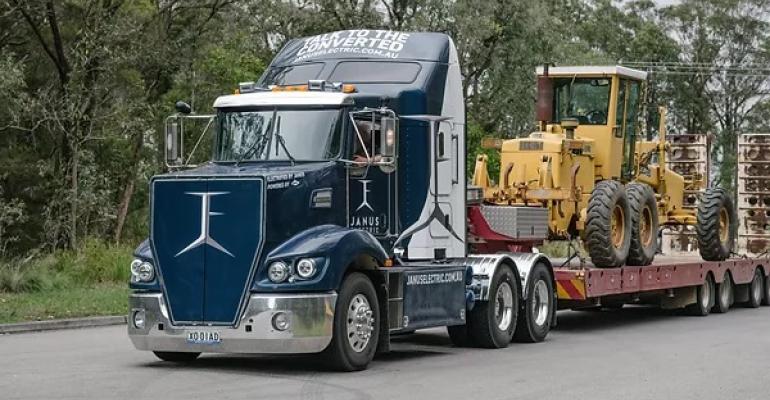Battery swap technology can restore stakeholders’ enthusiasm in battery-electric haulage, according to Lex Forsyth, co-founder and general manager of Australian start-up Janus Electric.
For the last two or three years, we have seen carriers and truck manufacturers lose faith in battery-electric drivetrains. First and foremost, this is because most fleet owners are unhappy with drivers’ two-hour ‘coffee breaks’ while their truck is connected to a DC charger. Fast progress in cell chemistry is yet another challenge.
Endless roll-outs of ever-better batteries is naturally good news, yet, long-haulers are built for many years of work and definitely not expected to be obsolete in just five years or so: “That’s why fixed battery solutions for Class 8 prime movers don’t make sense to me,” Forsyth said. He suggests that the battery swapping model’s three-minute ‘change and charge’ concept is the obvious solution to the industry’s charging time issue. However, it can also help to easily upgrade trucks for more advanced batteries: “We can just change the cell technology in the pack as soon as a new one becomes economically viable.”
The swap infrastructure can also increase use of the existing power capacities because charging can be paused, when the demand is at a peak, and some of the stored energy can even be sold back to the grid in those periods. Forsyth said: “Everyone seems to think that electrical grids just support fast charging because they put DC chargers everywhere but fast-charging technology conflicts with the grids’ necessity to use as much renewable energy as possible.” This sentiment is supported by a recent research work that showed a conflict between wind and solar generation’s capabilities and the spike-shaped demand for energy from DC chargers, reported by TU-Automotive.
This dilemma is also visible through charging networks’ slow expansion, Forsyth said: “In turn, truck makers see that electric mobility is definitely the future, however, they also meet a lot of constraints in Australia and other countries because of the grid’s low ability to support charging.”
So why hasn’t ‘change and charge’ technology been adopted worldwide? Even in China where commercial pilots in this area started a while ago, battery-electric trucks remain an extremely small niche and swap-designed fleet is still a three-digit number. Instead, key stakeholders such as investors or vehicle makers, one by one, nail their colors to the hydrogen mast.
Battery skeptics
Forsyth thinks this is because prototypes, functional and scalable ones, are of critical importance to overcome skepticism: “We had many discussions with OEMs and used to meet a lot of disbelief in feasibility, in terms of engineering, of making their vehicles work as electric without spending hundreds of millions of dollars. A lot of people were struggling to understand how a semi-trailer, or a road train can be a logical combination with an electric vehicle.” In his experience, the attitude changed radically when people were shown a working scalable prototype: “The big thing we need to realize is that the ‘change and charge’ model is neither an industrial nor a technology revolution. We just take the best technologies from around the world and join them in a smart and logical way to get closer to carbon zero.” Potentially, power utilities can be a major investor in the swap infrastructure. However, this will only happen when they figure out how it benefits them: “[Electricity suppliers] still need to understand that we are a flexible load, not a constant one.”
Even now when the concept has proved it can be successful, it will take a considerable time before the swap technology receives considerable spread. “It’s still hard to convince operators in fleets that electric versions of trucks can do the job as good, if not better than diesel vehicles,” he said. “However, a century ago, you could tell the same thing about a slow uptake of diesel trucks. [And] we still have to build a network. I suppose, in two or three years from now, when more infrastructure has been built, you’ll ask another question: ‘How many more days will the diesel trucks still be in use?’”
“I also honestly think that if battery packs were standardized, it would lead to faster electrification of fleets around the world. “Naturally, we hope that our ‘change and charge’ technology will be taken up as the standard for swappable batteries for Class 8 prime movers around the world. We’re very much an open-source business and want to collaborate with battery manufacturers to produce swappable batteries for the whole industry. In this, we push to zero emissions. It’s just common sense to do it, it’s the right thing to do for the environment, our communities, and our countries.”





